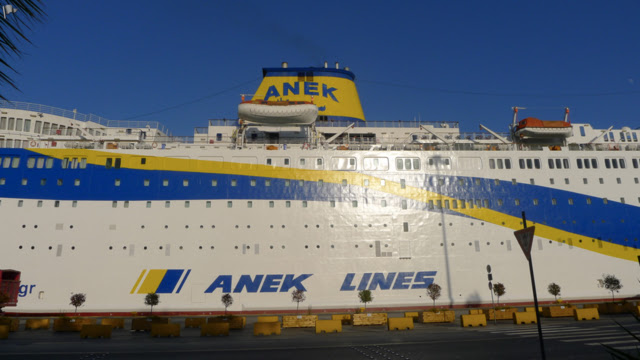While appalled by the capsizing of the Costa Concordia off the coast of the island of Giglio,
the reality of the magnitude of these behemoths was brought home by a couple of recent close encounters and these lead to some reflections and questions.
A disclaimer is probably in order. We have never gone on a modern cruise ship (and probably never will). As an anarchist at heart, I hate large hotels on land and organized tours, so I am not the ideal target for cruise ship advertisments.
While in Venice earlier this year, strolling down the via Guiuseppe Garibaldi in the Castelo district, we looked up and were confronted by this amazing site at the end of the road.
It is no wonder that there is a major battle in Venice between the tourist industry which benefits from the thousands of tourists from these ships and the residents who see these ships as destroying the environment; the wash from a huge cruise ship does a great deal more damage than that of a gondola
or even a vaporetto.
The pressure that these ships put on the seabed as they go in the shallow lagoon waters literally makes Venice shake. These ships move down the Guidecca Canal, which, depending on tide and how recently dredging has occurred, may have parts that are only 11 metres deep. The large cruise ships often have a draught in excess of 8 metres so they could easily hit the side of the dredged channel.
Immediately after the Costa Concordia accident, the Italian government put restrictions on the large cruise ships in coastal waters including in the Venetian Lagoon– but then lifted them after high pressure lobbying by the cruise lines. There is an on-going effort to restrict access in Venice, but it will probably take more than UNESCO and millions of people to move the Italian government.
Ironically, the Costa Fascinosa and Costa Favoiosa, sister ships of the same class as the Costa Concordia ,were built at the Marghera shipyard in Venice
and the new (and larger) flagship for the Costa Line is under construction there. Since this yard provides direct employment for 3,000 workers and is indirectly responsible for the employment of another 7,000, it is easy to see why Carnival Lines, the parent of Costa, has significant clout. And, guess what, the Marghera shipyard is part of Fincantieri – owned by the Italian government!
While we saw cruise ships at almost each island in Greece, they were most striking in Santorini, partly because of the contrast between their whiteness and the darkness of Santorini’s volcanic cliffs.
Seeing these ships in the caldera (collapsed volcanic cone) of Santorini causes reflections on other aspects of the cruising ships – at least they don’t have to worry about the water being too shallow – it is 300-600 metres deep!
What was most striking was the challenge of the logistics (people not supplies) for cruise ships in ports where they cannot dock, such as Santorini.
The day we were leaving Santorini, there were two major cruise ships unloading their human cargo for day trips - the Costa Fascinosa
and the Seven Seas Mariner.
With capacities of 3,780 and 700 passengers, respectively, this was a lot of bodies to move from the moored ships to the utterly unromantic port of Athinios,
There were about 50 charter buses covering virtually every square centimeter of the harbor area.
Smaller boats from the cruise ships made round trips bringing the passengers to the quayside from whence they were herded into their respective buses (labeled by destination and language)….
….. and then taken up the rather narrow and dangerous road up the cliff to partake of whichever tour they has subscribed to.
The only bus that seemed almost empty was to one going to Akrotiri, the most interesting place on the island. (More imn a leter blog about this amazing site that, like Pompeii, was preserved by being buried under volcanic ash - and is 1500+ years older than Pompeii).
We had to admire the smoothness of the operation although it took over an hour to get all the passengers to shore.
Perhaps the only cruise ship on which I would be tempted to sail was the Wind Star,
which, with only 148 passengers, was able to disembark its passengers right under the main town of Fira, to which the valiant could walk up on foot, or the more normal could go by funicular!
And to return to Venice while staying in Santorini, those Venetians who say it can’t happen here, should think about the Sea Diamond that sank at Athinios after hitting a rock despite being in some of the best charted waters in the world:
if it can happen, it will!!




























































